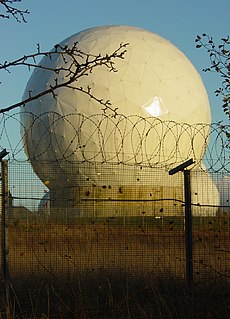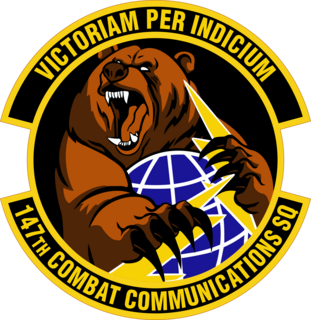
ECHELON, originally a secret government code name, is a surveillance program operated by the US with the aid of four other signatory nations to the UKUSA Security Agreement: Australia, Canada, New Zealand and the United Kingdom, also known as the Five Eyes.

The Government Communications Headquarters (GCHQ) is an intelligence and security organisation responsible for providing signals intelligence (SIGINT) and information assurance to the government and armed forces of the United Kingdom. Based in "The Doughnut" in the suburbs of Cheltenham, GCHQ is the responsibility of the country's Secretary of State for Foreign and Commonwealth Affairs, but it is not a part of the Foreign Office and its director ranks as a Permanent Secretary.

The National Security Agency (NSA) is a national-level intelligence agency of the United States Department of Defense, under the authority of the Director of National Intelligence. The NSA is responsible for global monitoring, collection, and processing of information and data for foreign and domestic intelligence and counterintelligence purposes, specializing in a discipline known as signals intelligence (SIGINT). The NSA is also tasked with the protection of U.S. communications networks and information systems. The NSA relies on a variety of measures to accomplish its mission, the majority of which are clandestine.

The Defense Information Systems Agency (DISA), known as the Defense Communications Agency (DCA) until 1991, is a United States Department of Defense (DoD) combat support agency composed of military, federal civilians, and contractors. DISA provides information technology (IT) and communications support to the President, Vice President, Secretary of Defense, the military services, the combatant commands, and any individual or system contributing to the defense of the United States.

The Communications Act of 1934 is a United States federal law signed by President Franklin D. Roosevelt on June 19, 1934 and codified as Chapter 5 of Title 47 of the United States Code, 47 U.S.C. § 151 et seq. The Act replaced the Federal Radio Commission with the Federal Communications Commission (FCC). It also transferred regulation of interstate telephone services from the Interstate Commerce Commission to the FCC.

The Communications Security Establishment, formerly called the Communications Security Establishment Canada (CSEC), is the Government of Canada's national cryptologic agency. Administered under the Department of National Defence (DND), it is responsible for foreign signals intelligence (SIGINT) and protecting Canadian government electronic information and communication networks. The CSE is accountable to the Minister of National Defence through its deputy head, the Chief of CSE. The Minister of National Defence is in turn accountable to the Cabinet and Parliament. The Agency has recently built a new headquarters and campus encompassing 34 ha. The new headquarters totals a little over 110,000 square metres and is adjacent to CSIS. The Chief of the CSE is currently Shelly Bruce, who assumed the office on June 27, 2018.

The Central Security Service (CSS) is an agency of the United States Department of Defense, which was established in 1972 to integrate the National Security Agency (NSA) and the Service Cryptologic Elements (SCE) of the United States Armed Forces in the field of signals intelligence, cryptology and information assurance at the tactical level. In 2002, the CSS had about 25,000 uniformed members.

The Government Communications Security Bureau (GCSB) is the public-service department of New Zealand charged with promoting New Zealand's national security by collecting and analysing information of an intelligence nature.
A health department or health ministry is a part of government which focuses on issues related to the general health of the citizenry. Subnational entities, such as states, counties and cities, often also operate a health department of their own. Health departments perform food inspections and other health related inspections, vaccination programs, free STD and HIV tests, tobacco enforcement and cessation programs, and other medical assistance programs. Health departments also compile statistics about health issues of their area.The role of a health department may vary from one country to the other, but their primary objective is always the same; safeguarding and promoting health. In 1986, several of the world's national health departments met to establish an international guideline by which health departments operate. The meeting was in Ottawa, Ontario, Canada, and hence the guidelines established are known as the Ottawa Charter. The Ottawa Charter was designed to 'achieve Health for All'.

The Military Auxiliary Radio System (MARS) is a United States Department of Defense sponsored program, established as a separately managed and operated program by the United States Army, and the United States Air Force. The United States Navy-Marine program has been closed. The program is a civilian auxiliary consisting primarily of licensed amateur radio operators who are interested in assisting the military with communications on a local, national, and international basis as an adjunct to normal communications. The MARS programs also include active duty, reserve, and National Guard units; Navy, Marine Corps, and National Oceanic and Atmospheric Administration ships, and Coast Guard cutters and shore stations.

In times of crisis and natural disasters, amateur radio is often used as a means of emergency communication when wireline, cell phones and other conventional means of communications fail.

The Ministry of Transport (MOT) of the Government of the People's Republic of China is an agency responsible for railway, road, air and water transportation regulations. Before March 2013, it was not in charge of the conventional railway transportation, which was administrated by the Ministry of Railways. It is a member of the State Council of the People's Republic of China.
Title 47 of the United States Code defines the role and structure of the Federal Communications Commission, an independent agency of the United States government, and the National Telecommunications and Information Administration, part of the United States Department of Commerce. It also criminalizes damage by ships to underwater cables and defines how candidates for political office receive special access to broadcast stations. The Communications Act of 1934, the Communications Assistance for Law Enforcement Act, and the Launching Our Communities' Access to Local (LOCAL) Television Act of 2000 are codified in this title.

The National Protection and Programs Directorate (NPPD) was a component of the United States Department of Homeland Security. NPPD's goal was to advance the Department's national security mission by reducing and eliminating threats to U.S. critical physical and cyber infrastructure.

The United States Air Force's 147th Combat Communications Squadron is an Air National Guard combat communications unit located at San Diego, California.

The United States Air Force's 269th Combat Communications Squadron is an Ohio Air National Guard combat communications unit located at Springfield Air National Guard Base, Ohio.

The Special Communications and Information Service of the Federal Protective Service of the Russian Federation is a cryptologic intelligence agency of The Federal Protective Service of Russia responsible for the collection and analysis of foreign communications and foreign signals intelligence, as well as protecting Russian government communications and information systems,which involves information security and cryptanalysis/cryptography. It is the equivalent to the United States National Security Agency.

Twenty-Fifth Air Force, also known as Air Force Intelligence, is a numbered air force (NAF) within the United States Air Force (USAF), and serves as the Air Force's premier military intelligence organization. 25 AF was established on 29 September 2014 by redesignating the Air Force Intelligence, Surveillance and Reconnaissance Agency under Headquarters, United States Air Force, to a numbered air force aligned under Air Combat Command. The USAF also realigned the 9th Reconnaissance Wing and the 55th Wing under the new NAF. It is headquartered at Lackland Air Force Base, Texas.


















